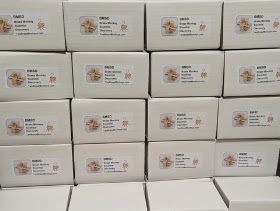I received my copy of this final instalment of Steve & Ali’s Brass Monkey series, the grand finale so to speak and it’s a gorgeous Sequential Discovery design that of course externally looks identical to its predecessors ‘BM 1 through 5’.
I’m so terrible at solving SD puzzles and don’t usually collect them but couldn’t pass this one up. I was hoping that my experiences with previous ‘BM’ puzzles would help me along with this one but so far nothing..lol
Well after a lot of head scratching moments I finally was able to ‘feed the Bananas to the Monkey’!!
Allard’s has posted a very nice review.
Here’s a description from Ali & Steve at Two Brass Monkeys
“When we decided to make the Brass Monkey series back in 2018, we always had six puzzles planned. BM1 being a standard burr with all the others having different tricks. Way back then we knew the solving mechanisms we wanted (never did want a BM…”the one that spins", "the one that taps" or "the one with magnets") and we always knew that BM6 would be "the sequential discovery one". We wish we'd made BM1 bigger as cramming the tricks into BMSD has been a puzzle for us! We've never given any hint to the secrets hidden within each BM and we're not doing so this time. Beyond saying there is more than one trick to find those “bananas”.
We've been through countless Kebab planning sessions, 3D printed prototypes, metal prototypes and play testing. Special thanks to Allard and Rich for their valuable feedback.
And yes, it required enormous restraint on both our parts not to call it Brass Monkey Sexential Discovery.
Like Brass Monkey 2, 3, 4 and 5….. Brass Monkey Sixential Discovery (BMSD) looks like a "standard" burr puzzle on the surface but hides even more trickery than usual beneath. It requires multiple discoveries to achieve the ultimate goal: Can you find the bananas and feed them to the monkey? There are in excess of ten steps needed to find the bananas.
Cheers and Happy Puzzling!”
I finally managed to make a Box to house my copy crafted from Bird’s Eye Maple and Peruvian Walnut with an Ash Sleeve. Top is Leopardwood, Bottom is Walnut. Slipfeathers are Peruvian Walnut/Padauk.














